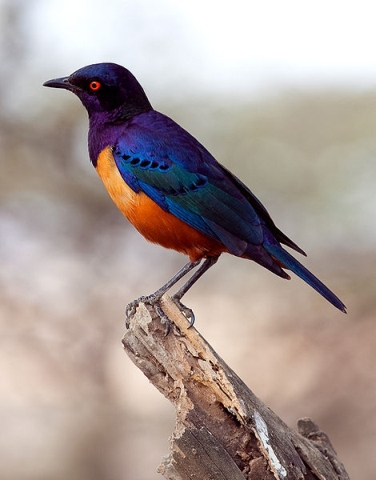There are many kinds of starlings but not in the western hemisphere. The only kind we have is the European starling, introduced in New York’s Central Park in 1890.
Unfortunately they’ve given starlings a bad name. They spread across the continent in less than 100 years, displaced native cavity-nesting birds, and now boast a population of 200 million. They’re ubiquitous in cities, noisy, and oily-looking. There’s not much to love about a starling…
…unless it looked like this!
This is Hildebrandt’s starling (Lamprotornis hildebrandti), a native of Kenya and Tanzania. Like our starlings it lives in relatively open areas and nests in cavities. The male and female look alike and the young are dull brown.
If only our starlings looked like this, perhaps we’d like them better.
(photo by Noel Feans from Wikimedia Commons. Click on the photo to see the original)

These guys look so similar to my favorite starlings at the Avairy. The royal (or golden-breasted) starlings there have the same iridescent feathers but a longer tail. I went to look up if they were related and found out they’re not even in the same genus. So they are only related in the same way a dog and a fox are related. I figured it would have been a closer relationship like a dog and a wolf.
Also…these guys have red eyes. Doesn’t look like they were mentioned in your post about red-eyed birds. http://www.birdsoutsidemywindow.org/2011/06/09/red-eyes/ so there’s one more.
I had a starling under my kitchen sink this summer… Full story and video here:
http://www.youtube.com/watch?v=_BgfpeK1hVA
Karissa, cool video! Here’s a theory on how the starling got into your basement — and from there into the hole under your kitchen sink.
Starlings nest inside the eaves of buildings and sometimes accidentally fall/walk into the space between the inner and outer walls. Once there, they try to get out but they can’t fly up (can’t open their wings far enough in the small space) so they go down and walk through any holes they find. After a long journey your starling found himself under your sink. He — and you– were mighty lucky he ended up where it was easy for him to get out.
Even though they are a pest, adult starlings are actually pretty IMHO. Noisy as all get out but pretty nonetheless.
My faves are the Cape Gossy Starling http://gallery.photo.net/photo/8506427-lg.jpg
and the Burchell’s Starling http://350.birdingafrica.com/wp-content/uploads/gravity_forms/2/2009/10/BurchellsStarlingWATA.jpg
I guess I’m partial to blue 😉
Something I didn’t know … Mynas are part of the Starling family ….. who knew?
Quick trivia fact: Starlings were introduced by fans of the poet Edgar Alan Poe, who released flocks of every kind of bird mentioned by Poe in his literature. I’ve also heard that they were rereleased a couple times after that to bolster the population. I agree with Sharon that European Starlings are rather pretty, but given a choice, I would rather they didn’t compete with native species. But don’t get me started on House Sparrows (ugh).